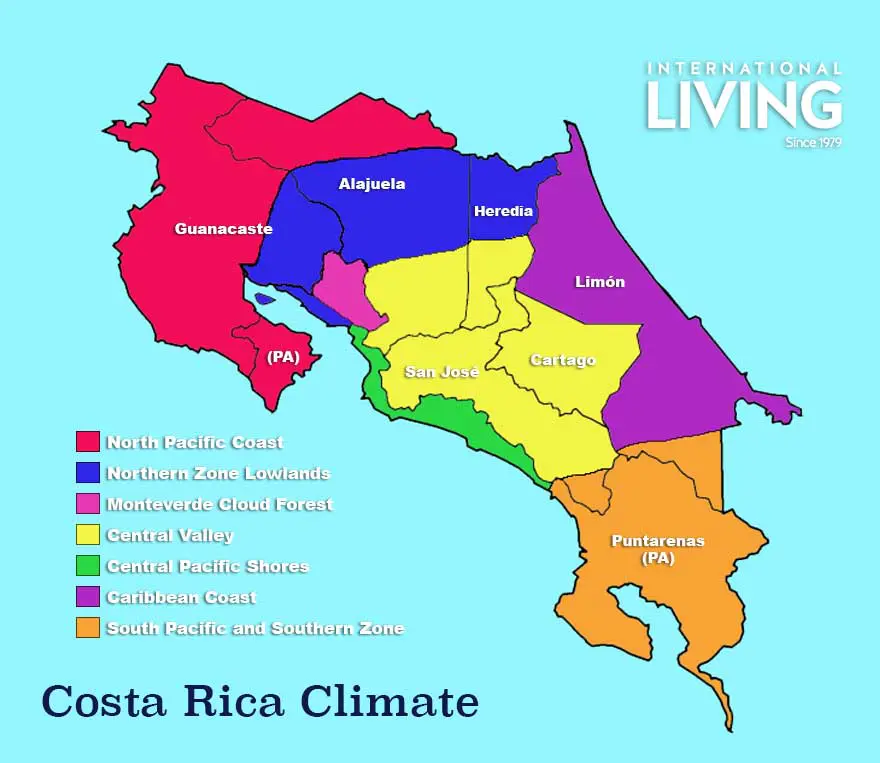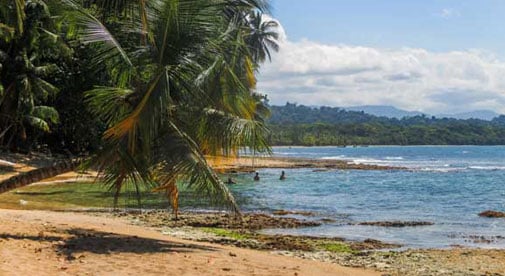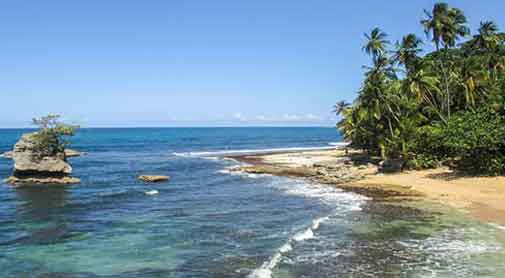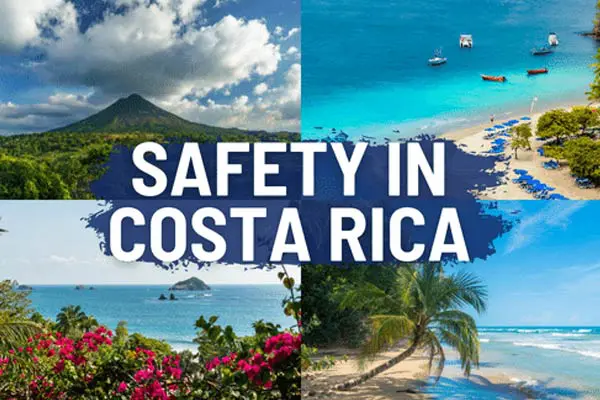Climate in Costa Rica - Costa Rica Weather is Notorious as Tropical
By Lou Kritz
People visiting Costa Rica are immediately impressed by the lush beauty, as well as the availability of diverse landscapes from beaches to mountain highlands to seaside flatlands, and much more. As questions arise about the weather, it becomes difficult, even impossible, to describe the variations in a few minutes. There is just too much information to boil it down to a few specifics. But, we’ll give it a try.
Those that live here find their local weather is governed by a macro and a micro system, or a large input that affects more of the whole country, and the micro effects of smaller systems that make your location just a little different.
Geography is the start. The small country of Costa Rica was formed over millions of years ago as undersea volcanos deposited island-building soils and rocks. In time the surface of the sea was broken and the volcanos filled in around undersea mountains and added to the isthmus, eventually joining everything together. A significant weather-affecting development is the angle of this country. It’s 285-mile length is laid on a northwest to southeast direction, giving it both a Pacific coast facing southwestward and a Caribbean coast facing northeastward.
A very important feature of Costa Rica is its spine; mountain formations that resemble a backbone. The 200+ extinct, dormant, and active volcanos formed in a somewhat straight line from Cerro Chirripo in the far south, 273 miles northwest to the dormant Orosí Volcano near the Nicaraguan border. The differences in elevation that this geologic formation presents are important weather factors because they form a high barrier wall between the two sea level coasts. The northern peaks of the “backbone” begin at 6,286 feet on the Rincón de la Vieja Volcano and continue down through the center of the country to Turrialba Volcano at an elevation of 10,960 feet.
This wall-like system of mountains causes serious disruption of airflow patterns. On the Caribbean side of the country the northeast trade winds, alisios, blow heavy moisture-laden air almost constantly. When it hits the land and high mountains as they rise, the alisios dump most of their water on the Caribbean side of Costa Rica. That side has a very short dry season because of this.
The Pacific side gets southwestern trade winds from the ocean. However, the strong Humboldt Current, which begins in the Antarctic waters and hugs the South American coast as it travels northward, tends to dry out the trade winds with its cool temperatures. The remaining moisture, along with that of the weaker Equatorial Counter Current coming from the equatorial western Pacific, is dumped on the Pacific shores and highlands on the southwest of the country.
The two air masses do battle at the summit. The wet Caribbean air tries to top the mountains and dump more water on the Pacific side. The Pacific air says, “No way, baby. Stay on your own side of the ridge.” During dry season the Pacific air is stronger and keeps the Caribbean gusts at bay. In the rainy season, the Caribbean wins, and you don’t have to water your garden for a while.
Microclimates in Costa Rica: The Backyard Weather
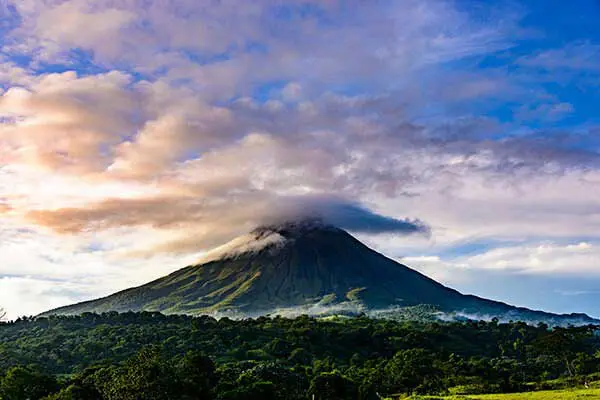
The second main weather feature you will deal with is the much smaller microclimates that abound. There are many over the country and the paragraph below will focus a little deeper on them. These microclimates are areas that are affected more locally than nationally by the trends that provide light, temperature, wind, etc. They can be helpful to your gardening efforts, or absolutely frustrating if you try to grow the wrong flower, fruit, or vegetable.
The microclimates are mostly a result of elevation, and it often depends on where you are perched. On all the mountains here in Costa Rica, average highs are in the mid-70s F and average lows in the low 60s F. Go higher and those temperatures may be in the low 70s F and high 50s F at night. Doesn’t sound like very much, but it can be a significant difference.
For example, Loraine, my wife, loves orchids. In the U.S. she would buy a potted orchid, take it home and pamper it, then watch it wilt away, then toss it out and buy another. Here, they seemingly grow wild. Several years ago, Loraine was gifted with a beautiful purple Cattleya orchid. She started to talk to everybody she could about it, growers, dealers, aficionados, to learn how to do it right. The flower spent a year in a corner window and grew into five blooming spikes. She was advised to carefully split them apart and put them on tree trunks or logs. She did that, but they seemed to stagnate until our friend, Ana, said, “Too much sun.” They moved the display to an area where the plants would get bright morning sun and indirect afternoon rays. This, along with proper food and water, has produced a veritable showcase of blooms by just moving the plants into a slightly different sun spot. Microclimates are found at different altitudes, but they are also affected by direction. That is, exposure to the morning sun, burning-hot midday rays, or too much shade.
My home is on a ridge that runs from the summit of Poás Volcano down through our barrio, or village, of Carbonal, then down through the town of San Roqué, then down to Grecia. At an elevation of 4,377 feet, some mornings it’s cool enough to wear a sweater or light jacket here. I’ll go San Roqué (4,035 feet), a drop of 342 feet, and the temperature will rise two or three degrees. Then on to Grecia at 3,278 feet, with another drop of 755 feet, and it will be four degrees warmer than San Roqué, and I’ll wish there was a place to store the jacket!

Understanding microclimates is a necessity before you settle in and buy a house. We always recommend renting for a while to learn about the area (before you’re stuck with the home that won’t let you grow tomatoes outdoors because the hot midday sun cooks them on the vine).
On the plus side, these differences make it interesting. We live surrounded by coffee and sugar cane fields that thrive in this environment. We’ve not only become coffee nerds, but watch the farmers and pickers as they work all year to produce Costa Rica’s outstanding crops. We’ve made new tico friends in the process.

Get Your Free Costa Rica Report Here:
Learn more about Costa Rica and other countries in our daily postcard e-letter. Simply enter your email address below and we'll send you a FREE REPORT – Costa Rica: The Land of Pura Vida
This special guide covers real estate, retirement and more in Costa Rica and is yours free when you sign up for our IL postcards below.
The Seasons of Costa Rica

Every visitor to Costa Rica asks about the seasons, and is surprised to learn that there are only two, as opposed to the four that most of the world experiences. The reasons for this anomaly are easy to explain, but then the exceptions to the rules pop up to complicate matters.
First, being between 8º and 10º north of the equator means that seasonal variations due to the changing earth’s tilt are not a big factor, and in the process eliminate spring and fall. The strength of the ocean trade winds, including the Caribbean alisios and the southwest Pacific drivers, are bigger factors and are affected and guided by things like El Niño and La Niña and Atlantic tropical storms.
The result is the country’s two distinct seasons. The dry season, called verano, begins in early December and goes through April. The second is the rainy season, named invierno, which is a May through November event. While this applies to most of the country, there is some variation along the Caribbean side, which experiences almost year-round rainy conditions.
The ticos call the dry season “summer” and the rainy season “winter,” basing the colloquial naming on the rainfall, not the temperatures. Costa Rica’s average yearly temperature of 76 F causes this, which is confusing to expats moving from a four-season climate.
The microclimates cause very little change year-round. Sunlight hours stay steady at 12 hours per day, varying only slightly in the 5:45 a.m. to 5:45 p.m. schedule. The only changes are some rainfall amounts that are affected by elevation. The ocean current changes, however, affect surfing.
Larger Pacific swells during rainy season, September and October, and Caribbean activity in November through May reflect this.
The big question potential visitors often ask is, “Should you visit Costa Rica during the rainy season?” The answer is “yes,” because it’s not a monsoon season. Most rainy season days begin with a sunny, warm morning that gets a little cloudy around lunch time, then produces a rain shower for ten minutes to two hours in the mid-afternoon. The evening is balmy and comfortable in time for a relaxing Costa Rica repast.
What About Climate Change in Costa Rica?

With much of the world’s climate thrown into turmoil as oceans rise and temperatures change, it seems logical to ask that question. So far, the noticeable changes have been mostly around timing. The starting dates of dry/rainy season onsets seem to be changing slightly. In 2019, for example, the rainy season lasted about three weeks longer than normal. While most of us didn’t notice the change, it affected the coffee crop. Harvesting begins at the start of the dry season. The late rains caused the first pick to fall off the bushes and rot, causing an 8% to 10% drop in production. Mother Nature was sorry, however, and this year there is a bumper crop.

Get Your Free Costa Rica Report Here:
Learn more about Costa Rica and other countries in our daily postcard e-letter. Simply enter your email address below and we'll send you a FREE REPORT – Costa Rica: The Land of Pura Vida
This special guide covers real estate, retirement and more in Costa Rica and is yours free when you sign up for our IL postcards below.
Regional Weather in Costa Rica
Even with so many variables that affect the weather, Costa Rica has a number of regions that have similar traits. Presented here are seven regional descriptions that allow the visitor to choose preferences that would make the visit, or even residency, more enjoyable. It’s important to note that there can be differences caused by microclimates or geographical conditions, so a closer inspection may be helpful.
Please note that most of the regions share the same timing of the seasons; i.e., dry season from December through April, and rainy season from May through November. The few variations are noted in their descriptions.
1. North Pacific Coast Nicoya Peninsula, Guanacaste
Includes: Liberia, Tamarindo, Playa de Coco, Rincon de la Vieja, Montezuma
This northernmost area of the country is noted for its flat, forested lowlands, with hot and dry weather.
2. Northern Zone Lowlands
Includes: Arenal, La Fortuna, the Sarapiqui Valley in the broad flatlands
This region is influenced by the Caribbean and its trade winds. Here you’ll encounter rainforests, high daytime temperatures, and cool nights.
3. Monteverde Cloud Forest
Seasons: January through May is dry, and June through December is wet.
Includes Monteverde and a small surrounding area
This area is important because the rainforest is a uniquely different occurrence. It gets little rain, but a daily cloud blanket that produces water that drips off the foliage, feeding the moss carpet and the stunted trees.
4. Central Valley
Includes: San José, Grecia, Santa Ana, San Ramón, Cartago
Central highlands with a mild climate, and cool at night.
5. Central Pacific Shores and Beaches
Includes: Pacific coast from Puntarenás, to Jacó, Manuel Antonio, Quepos
Oceanfront lowlands that are hot and humid with rainforests.
6. Caribbean Coast
Seasons: February & March are dry, and September & October are very dry
Includes: Puerto Viejo de Talamanca, Tortugero, Limón
Broad Caribbean beaches and coastal flatlands, very warm and wet for eight months.
7. South Pacific and Southern Zone
Includes: Osa Peninsula, Dominical, Golfito, Corcovado, La Amistad International Park
Pacific oceanfront lowlands that are hot and humid with rainforests.
Check it Out to Be Sure

We have learned the value of a tourist visit if you plan to consider moving to Costa Rica. A visit to your potential new home allows you to assess and understand housing, transportation, medical care, and much more. The weather can be a big part of the decision.
Begin at the coastal lowlands and beaches on either side of the country and experience the hot, humid oceanic air, with balmy ocean breezes at night that allow veranda dining and a good night’s sleep. Then, perhaps, move to mid-elevation towns and barrios where the days will be in the invigorating middle to high 70s F, with cooler evenings so you can sleep and get ready for another day. If you’re really adventurous, there are many mountain-top homes with views to impress, if you can stand the sunny, cooler days and the crisp nights that produce those gourmet coffee varieties you love.
When you make your decision to enjoy the pura vida lifestyle, the weather type you fell in love with will be waiting for you.
Featured Image Copyright: ©Lightphoto/iStock



